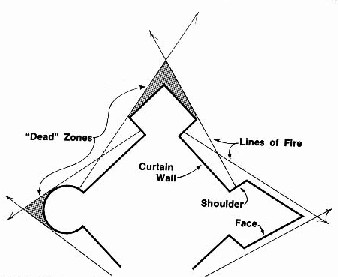
Middle Age castle: Krak des Chevaliers, the greatest of the Crusader Castles.

This ended abruptly with the emergence of the gun-powdered Bombard at the beginning of the 15th century. It was able to fire huge stone balls against the foundations of the walls, thereby making them collapse. This new development gretly reduced the old castles effectiveness against enemies, who could afford the new bombards.
The mighty walls of Constantinople, which had protected the city from enemies for a thousand years, crumbled under the fire of the bombards of the Ottoman Sultan Mohammed the Conqueror. The first Western Ruler who used them systematically was the king of France in 1450. This lead to the defeat of the English after a century of warfare, thus ending the Hundred Years War in 1453.
In the early 1500s an important discovery was made in Italy: cannonballs fired into a wall made of earth buried themselves into the soil without doing much damage. This lead to a new type of fortifications able to withstand enemy fire, the Trace Italienne .

Guns were not only used for attack, but also to defend. Therefore a new construction was included in the Trace Italienne, replacing the older castle tower: the bastion. Here the guns could be positioned in relative safety, and at the same time they had good lines of fire.

The emergence of the Trace Italienne once again made fortifications almost impossible to attack successfully in battle. So just as it had been the case in the Middle Ages, food supply in the fortifications became the decisive factor.